Confluence Kitchen Garden 2025
- Phyllis Sanders

- Aug 10
- 6 min read
Updated: Aug 10
There’s something magical about a garden, a small a pot of herbs on the windowsill, or a backyard full of wildflowers, the moment you step into it, the pace of life shifts. The air feels different, the colors seem richer, and time stretches just enough to notice the bee landing on a bloom, or the smell of damp soil after rain. A garden isn’t just a place where plants grow, it’s a place where you can breathe a little deeper, and look a little closer.
More than a pleasant pastime or a way to beautify a space, gardening is a living conversation between people, the land, and the rhythm of the seasons. For centuries, tending plants kept us alive, giving us food, medicine, and materials. Today, it plays a crucial role in restoring ecosystems, supporting biodiversity, and mitigating the effects of climate change. Every seed planted in a backyard, on a balcony, or in a shared community plot, becomes part of a larger network that sustains people and the planet.
This year, we let go of perfection. We tossed kitchen-scrap seeds into the soil, bought just a couple of plants from the local garden center, and watched to see what would happen. After years of gardening, a recent move, and some unexpected health challenges, we wanted to keep things low-cost and low-pressure, letting the garden grow with us instead of asking more than we could give. When you’re living with physical disabilities, chronic illness, or mental health challenges, even simple garden tasks can be demanding. Some days, all that can be done is to step outside, observe a new bloom, and let that be enough.
The benefits of gardening go far beyond what can be harvested. Study after study shows it can lower stress, ease anxiety, and spark a sense of accomplishment. There’s something grounding about digging in the soil, watching the seasons shift, and caring for living things. For those navigating depression, anxiety, or trauma, a garden can be a reminder that growth takes time, that rest is part of the cycle, and that beauty can come from what might otherwise be thrown away. In a garden, mistakes often become surprises, and a single seed can benefit people, pollinators, and the soil. Some years all the garden does is feed the "pests", the army worms and aphids, and that's honestly okay too. Sometimes nature has different plans, and new lessons for us to learn.
Beyond what gardens gives us personally, a garden is a lifeline for wildlife. It offers food, water, and shelter to pollinators, birds, and countless other creatures, especially in urban and suburban areas where natural habitats have been paved over. Native plants help restore the balance by supporting species that have evolved alongside them. Green spaces cool the air, filter pollutants, and absorb stormwater, making even the smallest garden an important tool for climate resilience.
This year, our garden is a little wild, a little imperfect, and full of life. That feels like a win.
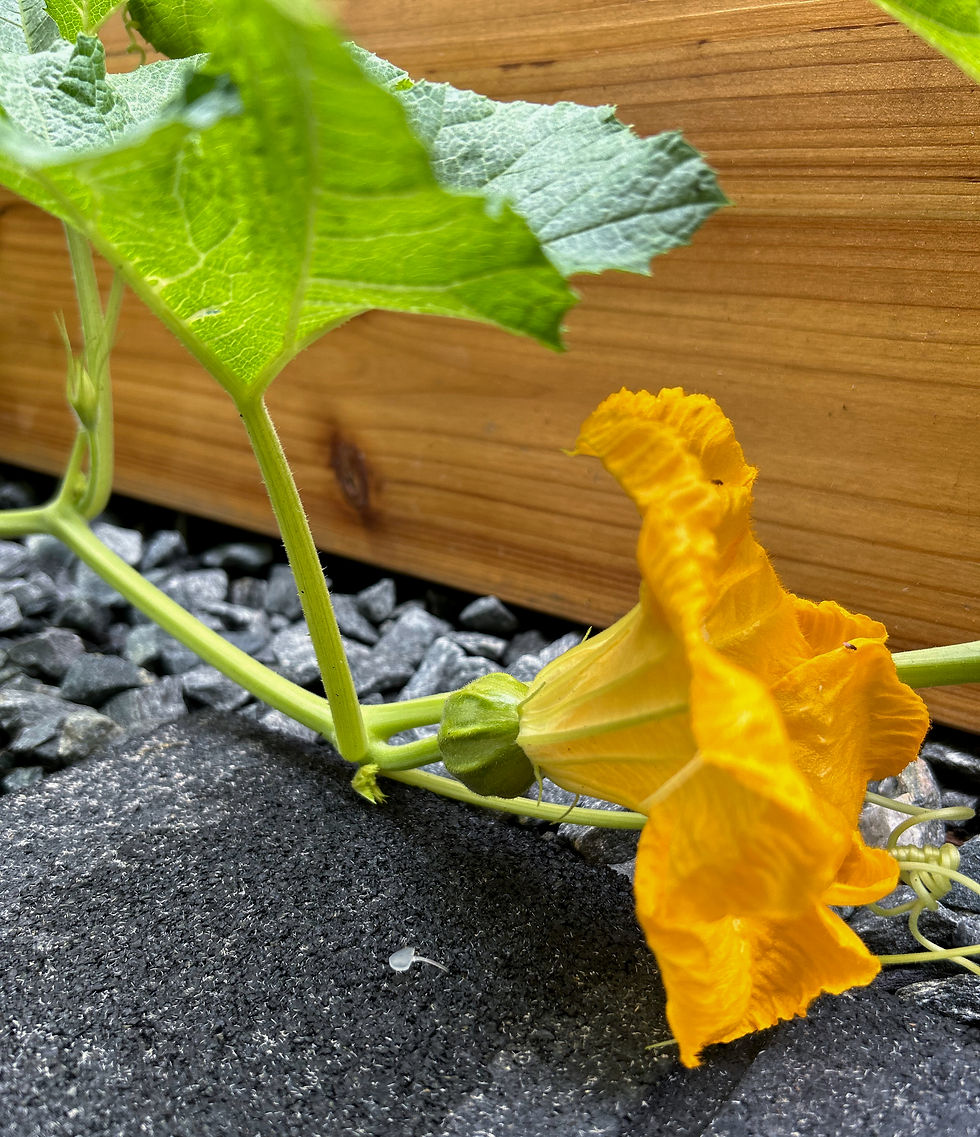
Corn & Pumpkins
In the corner of the garden photo, you’ll see corn and a massive pumpkin plant stretching from the back corner all the way to the front. Last fall, after moving in, we started a casual compost pile and tossed pumpkin, corn, and other food scraps there. Now it’s a sprawling patch of blossoms and habitat for our garden friends and pollinators. The pumpkins have practically taken over everything, including our now nonexistent compost pile, and we love it!

Sunflowers
We planted two rows of sunflowers from seeds we saved two seasons ago: a row of mammoth sunflowers in the back and mini sunflowers in the middle, with pumpkins in the front. The mammoth sunflowers didn’t really take off (not sure why), but our mini sunflowers are thriving, some are already forming seeds! Can’t wait to harvest them for next year.
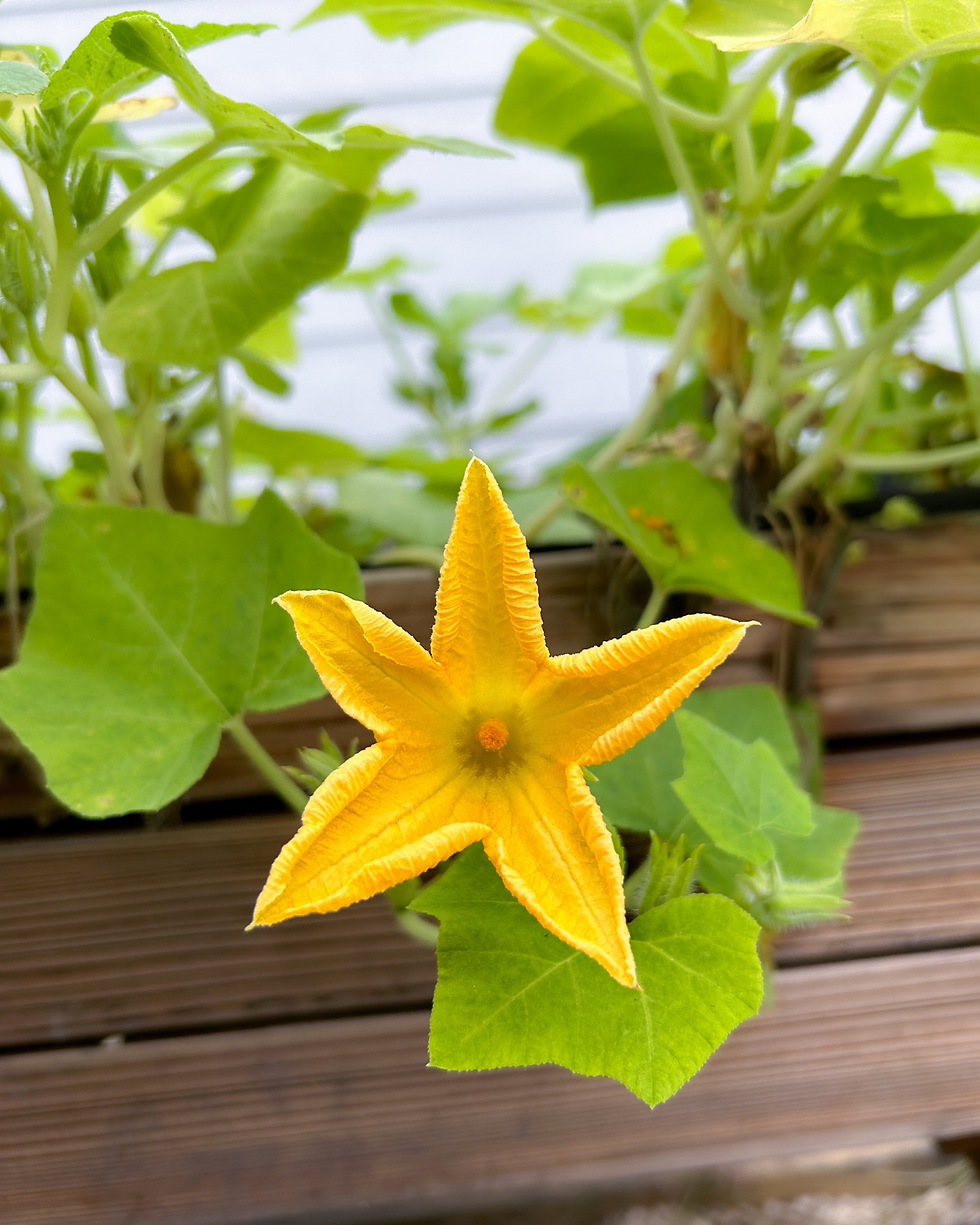
Butternut Squash
Our kitchen-scrap butternut squash seeds have been a hit again this year. This is our second year just throwing squash seeds straight into the soil, and honestly, it’s been easier and more successful than using store-bought seeds or transplants. We will have to thin them out soon, but right now, they look so lush and beautiful we hate to disturb them.
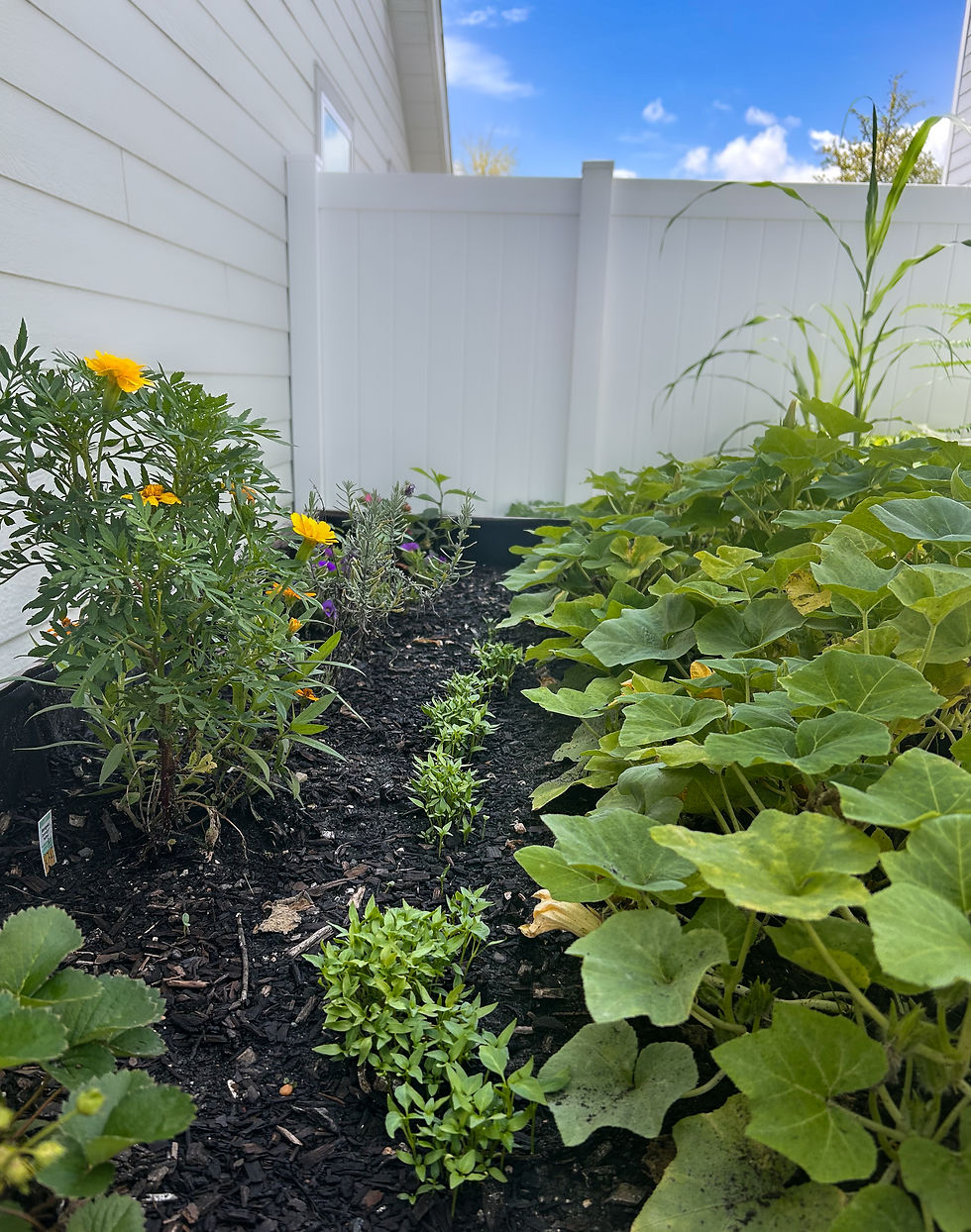
Bell Peppers
More kitchen scrap magic! We tossed some bell pepper tops and seeds into the garden just a couple of weeks ago, and they are already sprouting like crazy. The whole row behind the squash is coming in strong.
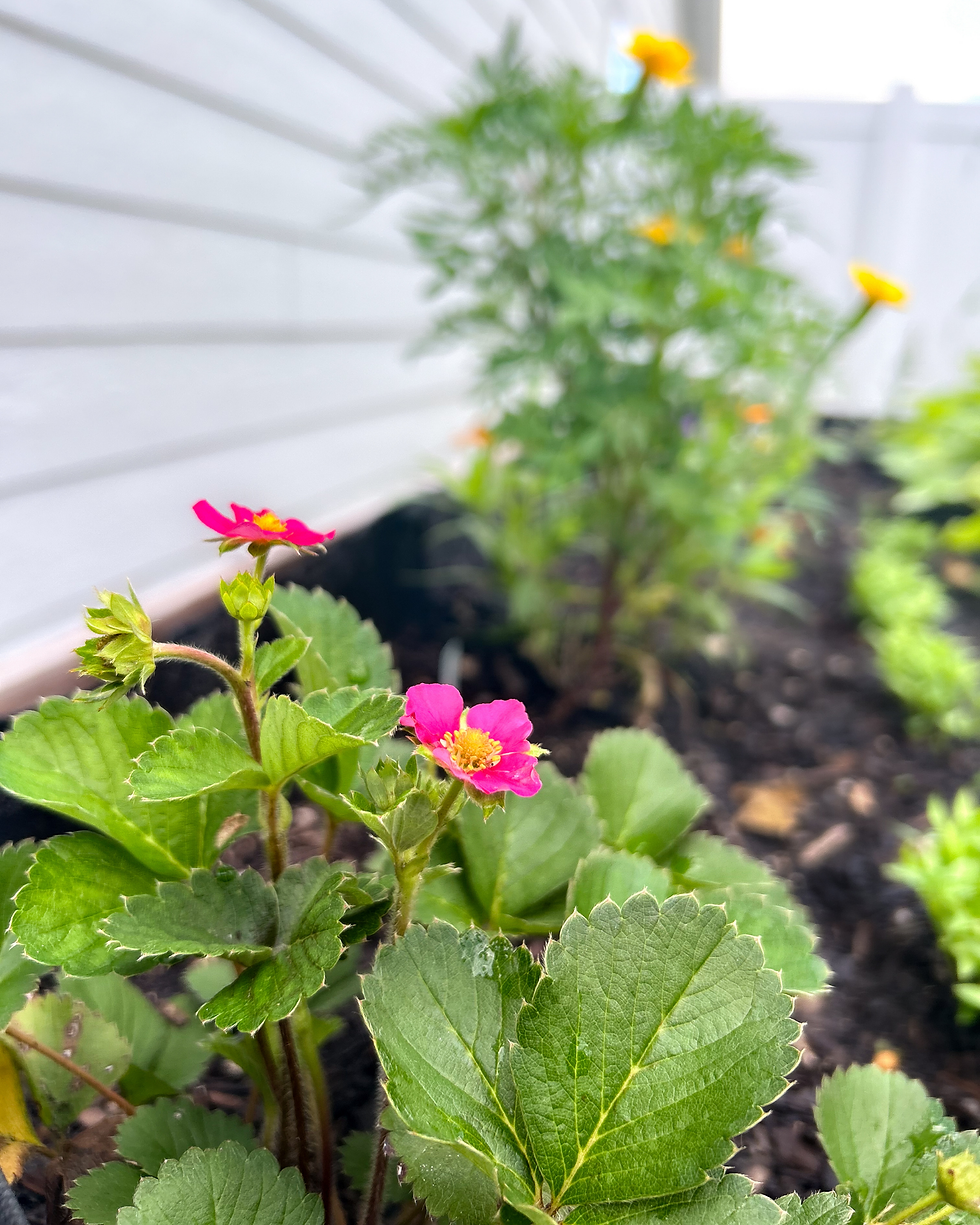
Strawberries
We bought two strawberry plants this year and planted them in opposite corners of our raised bed. Unfortunately, they’ve struggled to take off. We have had strawberries go wild in the past, but this season has been pretty meh for them.

Carrot & More Bell Peppers
The carrot top came from our kitchen scraps, we planted it in this grow bag to see what would happen, and it looks pretty happy. We have had a lot of success in the past taking onions, garlic, and potatoes, and other scraps, and just putting them in soil or a jar of water. Excited to see how big this carrot is under the soil. The bell peppers pictured are a mix of purple, yellow and orange. We picked these up on one of our outings because our sweet little toddler chose them and insisted we needed these purple peppers. The shorter bed is his little sunflower pumpkin patch, and he loves it.

Herbs
We always love a garden full of herbs, but this year it was tricky to find them at the garden center, and some take a while to grow from seed. We have mint, sage, purple and regular basil, lavender, and a few others. Fingers crossed for more herbs this fall so we can propagate for next year’s garden.
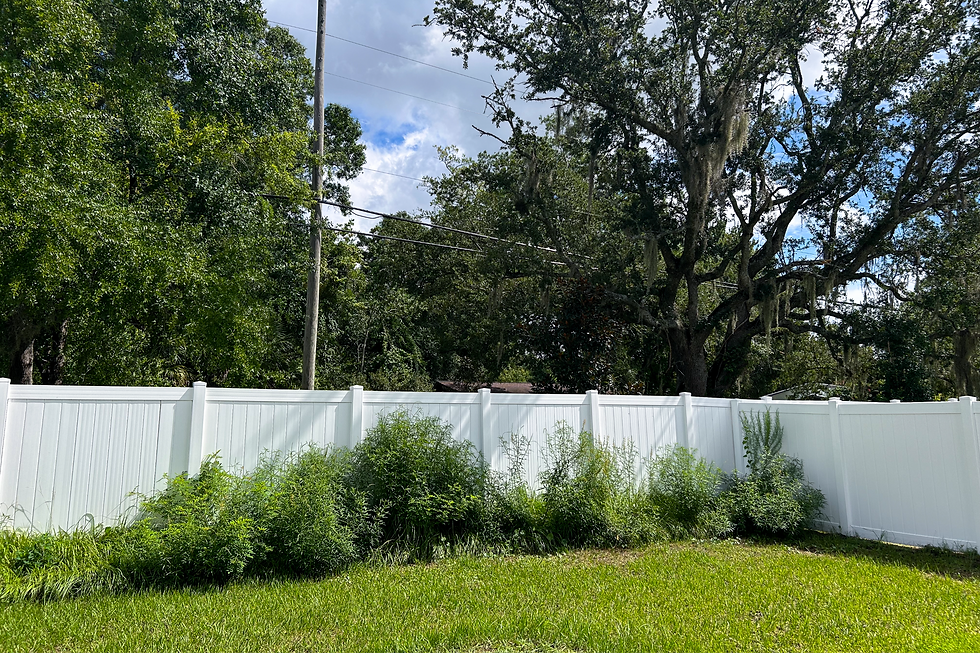
No Mow Wildflower Patch
We still have our No Mow Wildflower Patch going strong in another part of the yard. Sadly, none of the wildflower seeds we scattered (we are talking two giant native seed bags), took root. We suspect the ants, lizards, and other critters treated those seeds as a tasty snack. Even without the flowers, the native plants and wild grasses have created a thriving habitat for lizards, dragonflies, beetles, wasps, frogs, snails, and all kinds of backyard critters, likely including a snake or two...it is Florida, after all...
We highly recommend dedicating one little corner of your backyard to the wild, just let it grow and see what happens.
This year, we’re working toward becoming a Certified Pollinator Steward through the Pollinator Partnership. Pollinators are in crisis, habitat loss, pesticides, and climate change have put enormous pressure on the species we rely on for one-third of our food supply. Being a steward means learning how to create and protect pollinator-friendly spaces, sharing that knowledge with others, and making choices in our own yards that help these essential creatures.
We had plans to create a neighborhood butterfly garden, but our HOA has been slow to respond and has made non-community oriented decisions, so we’ve shifted our focus to our own plot. Even here, in our little wild and imperfect garden, we’re making room for pollinators, native plants, and the small habitats that make a big difference. Every patch of pollinator habitat matters, whether it’s a sprawling meadow, a raised bed, or a few blossoms in a corner of the yard.
We are passionate about making it easier for everyone to get involved in helping the environment, and show just how much small actions can truly make a global impact. We've found some fantastic opportunities for you to make a difference. Whether it's through activities you're already doing or you are just getting into gardening, learn about these five impactful ways you can contribute to supporting bees and other pollinators, along with recognition you can earn for your efforts.
More garden updates to come, probably closer to harvest season! We will add more tips and tricks, and information about sustainable gardening practicing in our next update. Stay tuned!
Gardens have a way of bringing people together, sharing seeds, swapping stories, and celebrating the little wins (and even the flops). We would love to hear about yours. Do you have a garden, big or small, that’s brought you joy or taught you something unexpected? Tell us in the comments, send us a photo, or reach out if you’d like to share your story in a future post. Every garden has a tale worth telling, and we can’t wait to learn from yours.
.png)























Comments